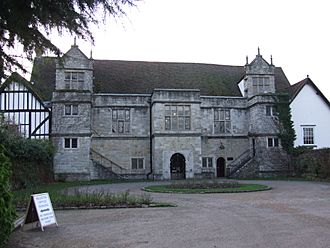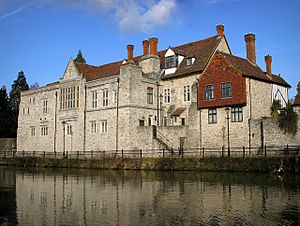Archbishop's Palace, Maidstone facts for kids
Quick facts for kids Archbishop's Palace |
|
|---|---|

The entrance frontage of the Archbishop's Palace
|
|
| General information | |
| Town or city | Maidstone |
| Country | England |
| Coordinates | 51°16′17″N 0°31′14″E / 51.2713°N 0.5205°E |
| Completed | 14th century, 16th century |
The Archbishop's Palace is a really old building in Maidstone, Kent. It stands on the east bank of the River Medway. This historic place was built in the 1300s and 1500s.
It used to be a special home for archbishops from Canterbury when they were traveling. Today, it's mostly used for weddings! There's also an old barn nearby, which was once part of the palace. This barn is now the Tyrwhitt-Drake Museum of Carriages.
Contents
History of the Palace
How the Palace Began
The land where the palace stands was probably given to the Archbishops of Canterbury a very long time ago. This was likely in the 600s or 700s. In 1207, a house on this spot was given to Archbishop Langton. It was a place for archbishops to rest when traveling between London and Canterbury. This house was later taken down by Archbishop Ufford.
Building the Current Palace
The first work on the palace you see today started in 1348. Archbishop Ufford ordered this work. Archbishop Islip continued building from 1349 to 1366. Some materials even came from another palace!
Later, in the late 1300s, Archbishop Courtenay made the Maidstone site even bigger. He started the nearby College and Church of All Saints. The palace itself was made larger and better by Archbishop Morton in 1486.
The Palace Changes Hands
The palace and the College were given to Henry VIII by Archbishop Cranmer. This was part of an exchange for other properties. Henry VIII then gave the palace to Sir Thomas Wyatt.
However, in 1554, the property was taken back by the Crown. This happened after a rebellion led by Sir Thomas Wyatt's son, Thomas Wyatt the younger, against Queen Mary I. Later, Elizabeth I gave the palace to Sir John Astley.
Sir John Astley added a lot to the palace, building much of what we see today. When he died in 1639, he left the palace to Jacob Astley, 1st Baron Astley of Reading. Lord Astley died there in 1652. The palace then passed to his son and grandson. In 1688, the grandson died, and the palace went to his cousin, Sir Jacob Astley, 1st Baronet.
In 1720, Sir Jacob sold the palace to Robert Marsham, 1st Baron Romney. He lived at a nearby house called Mote House. The Marsham family later sold the palace. In the early 1900s, it was used as a medical school for the Territorial Army.
The Palace Today
Today, Kent County Council looks after the palace. It is mainly used as a register office for things like births, deaths, and marriages. You can only visit the palace on special "Heritage Days."
The Kent Garden's Trust takes care of the Apothecary's Garden. This garden is open to the public on Wednesday afternoons from May to August.
What the Palace Looks Like

The palace building looks like the letter "E" from above. It sits on the east bank of the River Medway. It is also very close to where the River Len joins the Medway.
The middle part of the palace has two floors. It is built from smooth, cut stone called ashlar. The main entrance is through a porch that sticks out from the front. On each side of the central part are wings made of timber (wood). The roof is covered with clay tiles. There are two stone windows sticking out from the roof on the front, with fancy tops.
The back of the palace has windows of different sizes. Many of them have stone frames. There is also a large, fancy window that sticks out from the wall.
Other Buildings Nearby
Close to the palace, on the south side, is the dungeon. This is a stone building from the 1300s. It has small windows and a very old Norman basement.
To the north-east of the palace is the gatehouse. This building is from the 1200s and 1300s. It has two floors and is made of rough stone and timber. The roof is tiled. There's even an old toilet area that sticks out from the side!
The Archbishop's Palace is a very important historic building. It is listed as a Grade I building. The dungeon is listed as Grade II*, and the gatehouse is listed as Grade II. The walls around the buildings are also listed as Grade II. The Dungeon is currently on a list of historic places that are "at risk" and need care.
Images for kids



